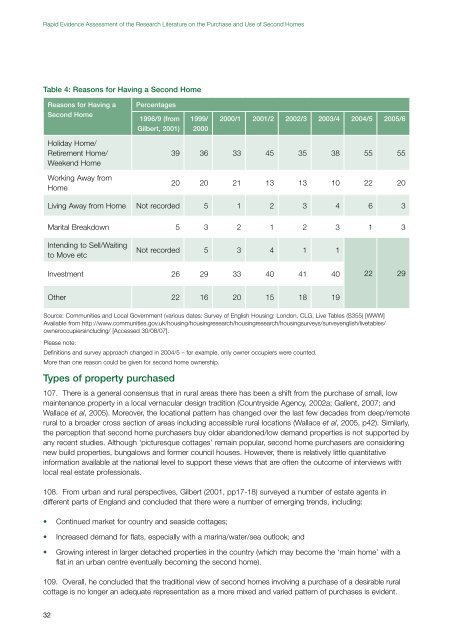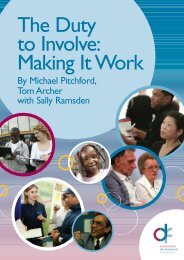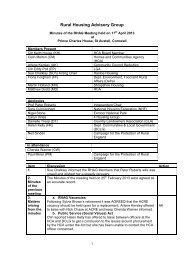Rapid Evidence Assessment of the Research ... - Rural Housing
Rapid Evidence Assessment of the Research ... - Rural Housing
Rapid Evidence Assessment of the Research ... - Rural Housing
You also want an ePaper? Increase the reach of your titles
YUMPU automatically turns print PDFs into web optimized ePapers that Google loves.
<strong>Rapid</strong> <strong>Evidence</strong> <strong>Assessment</strong> <strong>of</strong> <strong>the</strong> <strong>Research</strong> Literature on <strong>the</strong> Purchase and Use <strong>of</strong> Second Homes<br />
Table 4: Reasons for Having a Second Home<br />
Reasons for Having a<br />
Second Home<br />
Holiday Home/<br />
Retirement Home/<br />
Weekend Home<br />
Working Away from<br />
Home<br />
32<br />
Percentages<br />
1996/9 (from<br />
Gilbert, 2001)<br />
1999/<br />
2000<br />
2000/1 2001/2 2002/3 2003/4 2004/5 2005/6<br />
39 36 33 45 35 38 55 55<br />
20 20 21 13 13 10 22 20<br />
Living Away from Home Not recorded 5 1 2 3 4 6 3<br />
Marital Breakdown 5 3 2 1 2 3 1 3<br />
Intending to Sell/Waiting<br />
to Move etc<br />
Not recorded 5 3 4 1 1<br />
Investment 26 29 33 40 41 40<br />
O<strong>the</strong>r 22 16 20 15 18 19<br />
22 29<br />
Source: Communities and Local Government (various dates: Survey <strong>of</strong> English <strong>Housing</strong>: London, CLG, Live Tables (S355) [WWW]<br />
Available from http://www.communities.gov.uk/housing/housingresearch/housingresearch/housingsurveys/surveyenglish/livetables/<br />
owneroccupiersincluding/ [Accessed 30/08/07].<br />
Please note:<br />
Definitions and survey approach changed in 2004/5 – for example, only owner occupiers were counted.<br />
More than one reason could be given for second home ownership.<br />
Types <strong>of</strong> property purchased<br />
107. There is a general consensus that in rural areas <strong>the</strong>re has been a shift from <strong>the</strong> purchase <strong>of</strong> small, low<br />
maintenance property in a local vernacular design tradition (Countryside Agency, 2002a; Gallent, 2007; and<br />
Wallace et al, 2005). Moreover, <strong>the</strong> locational pattern has changed over <strong>the</strong> last few decades from deep/remote<br />
rural to a broader cross section <strong>of</strong> areas including accessible rural locations (Wallace et al, 2005, p42). Similarly,<br />
<strong>the</strong> perception that second home purchasers buy older abandoned/low demand properties is not supported by<br />
any recent studies. Although ‘picturesque cottages’ remain popular, second home purchasers are considering<br />
new build properties, bungalows and former council houses. However, <strong>the</strong>re is relatively little quantitative<br />
information available at <strong>the</strong> national level to support <strong>the</strong>se views that are <strong>of</strong>ten <strong>the</strong> outcome <strong>of</strong> interviews with<br />
local real estate pr<strong>of</strong>essionals.<br />
108. From urban and rural perspectives, Gilbert (2001, pp17-18) surveyed a number <strong>of</strong> estate agents in<br />
different parts <strong>of</strong> England and concluded that <strong>the</strong>re were a number <strong>of</strong> emerging trends, including:<br />
• Continued market for country and seaside cottages;<br />
• Increased demand for flats, especially with a marina/water/sea outlook; and<br />
• Growing interest in larger detached properties in <strong>the</strong> country (which may become <strong>the</strong> ‘main home’ with a<br />
flat in an urban centre eventually becoming <strong>the</strong> second home).<br />
109. Overall, he concluded that <strong>the</strong> traditional view <strong>of</strong> second homes involving a purchase <strong>of</strong> a desirable rural<br />
cottage is no longer an adequate representation as a more mixed and varied pattern <strong>of</strong> purchases is evident.






